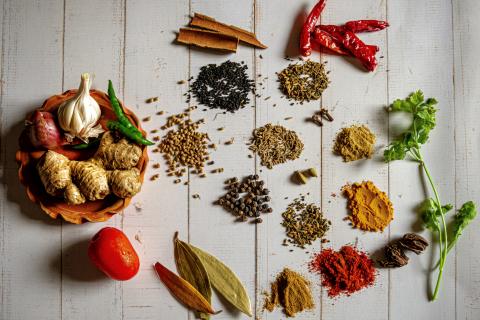5 Tips to Lower Your Blood Pressure
Heart disease is the current leading cause of death in the United States.1 Factors that increase the chances of developing heart disease can include high blood pressure, high cholesterol, overweight and obesity, diabetes, and lifestyle factors such as diet, exercise and cigarette smoking.2 In this article, we will look specifically at how high blood pressure, also known as hypertension (HTN) impacts heart health, and how it can be managed through simple diet changes.
Blood pressure is the pressure forced against the walls of your arteries in order to push blood from the heart to the rest of the body.3 Naturally, your blood pressure fluctuates throughout the day indicating changes in activity, or even emotions, but consistent exposure to increased blood pressure may be damaging to blood vessels and the body overall. The American Heart Association recommends blood pressure to remain <120 mmHg systolic and <80 mm Hg diastolic.3 Ranges above these may indicate high blood pressure, or hypertension. Currently, about half of the adult population in the United States has high blood pressure, or is prescribed hypertensive medications.3 Prescriptions such as diuretics, ACE inhibitors, or beta blockers can help to control blood pressure and reduce the potential progression of cardiovascular disease, but what if there was a way to control blood pressure without medications?4
Blood pressure can be measured at your routine doctors' visits, or often-times, can be measured at your local pharmacy through free screening stations.
The food we eat has a way of impacting different functions of our bodies. Vice versa, our body has a unique way of communicating what it needs more or less of. Certain foods and nutrients have a way of influencing blood pressure, and overtime can lead to hypertension and other not so favorable health outcomes. Hypertension is not something that occurs overnight, but rather accumulates overtime, so addressing chronic diseases through the diet may help to stop the progression in its tracks. Making the conscious decision to choose food options that both our tastebuds and our bodies like may be the connection it hopes for. Below are some of the most highly recommended and researched dietary changes to lower your blood pressure.
1. Minimize salt intake
Sodium (Na), a naturally occurring mineral, that when combined with chloride (Cl), makes what we know as salt (NaCl). Consistent consumption of high-sodium foods causes fluctuation in blood pressure which over time can lead to hypertension. One of the most documented and supported modifications for managing high blood pressure is addressing salt intake.5 The Dietary Guidelines for Americans recommends <2,300mg of sodium per day, but the average American consumes closer to 3,400mg per day.6 Too much salt causes the blood to become saturated with sodium – something the body doesn’t particularly like. To compensate, water will enter the bloodstream in an attempt to dilute the blood. This in turn increases the pressure required to move blood throughout the body because of the increase in volume.5 Despite sprinkling table salt atop your meals at home and in restaurants, excess sodium can be found riddled throughout packaged and processed foods.
**Spice it up: 6,7,8

- Consider swapping salt for herbs, spices, or reduced/low-sodium seasonings.
- When shopping, look for “low-sodium” or “reduced-sodium” options.
- Read the food label and identify whether the %DV for sodium is <5%.
- If applicable, drain and rinse any foods that may have been preserved in salt.
Have fun and don’t be afraid of getting creative with your seasonings to help reduce your use of salt when cooking. Reducing your salt intake will naturally reduce your sodium intake!
2. Minimize highly processed foods
Diets low in processed foods and higher in whole foods not only help to decrease your sodium intake, but also decrease your risk of high blood pressure. Convenience foods such as frozen pre-packaged meals, candy, soft drinks, packaged baked goods, chips, canned soups and many more can be full of additives and preservatives. When purchasing these types of foods, be sure to check the packaging for any nutrient claims (low-sodium, reduced-fat, reduced-cholesterol, etc.) as well as the nutrition facts panel in the back.
**Part of the Process: 9
- Check the nutrition facts panel and ingredient list on packaging for contents such as high-fructose corn syrup, modified oils, color, flavor or texture enhancers.
- Use your best judgement!
3. Incorporating whole foods into your meals
Minimizing your intake of highly processed foods opens the possibility for incorporating more whole foods. The National Institute of Health (NIH) had identified dietary habits to promote overall heart health, including lowering blood pressure.10 The Dietary Approach to Stop Hypertension, also known as the DASH diet, has been proven to not only reduce the risk of hypertension, but also promote healthier eating habits.10 The goal of the DASH diet is not to completely exclude a food group, but rather encourage greater consumption of a variety of whole foods such as fruits, vegetables, and whole grains, while limiting your intake of saturated fats, added sugars, sodium, and alcohol.7
**Look at the Whole picture: 7
- Start small and work your way up. Follow a DASH modified MyPlate guide.
- Make half of your plate fruits and vegetables.
- Consider meatless meals a couple times per week.
- Analyze the nutrition facts panel for things like saturated fats, added sugars and sodium.
4. Stay active:
Together, diet and physical activity can play a significant role in combating high blood pressure.8 The US Department of Human Health Services (USDHHS) states that regular moderate physical activity is a simple and non-prescribed way to help lower blood pressure and decrease your risk of HTN.8 Incorporating even the simplest of tasks such as taking the stairs, parking at the far end of a parking lot, or a 30-minute walk can have a significant impact on cardiovascular health.
**Keep it Movin’:
- Here are some benefits and additional tips for incorporating more activity into your daily routine (Move Your Way - What's your move? (health.gov).
5. Small steps = BIG changes:
Dietary modifications can sometimes feel overwhelming and difficult to accomplish, but it is important to remember that “Rome was not built in one day.” Rather than flipping your dietary habits 180 degrees, we should instead focus on making small, easily achievable changes one step at a time to reach our nutrition goals. If you are considering incorporating blood-pressure-friendly modifications or the DASH diet into your lifestyle, it may be best to speak to a Registered Dietitian about how changes to your diet could be made based on your individual needs.
References:
- FASTSTATS - leading causes of death. Centers for Disease Control and Prevention. https://www.cdc.gov/nchs/fastats/leading-causes-of-death.htm. Published January 13, 2022. Accessed February 28, 2022.
- Heart disease and stroke. Heart Disease and Stroke | Healthy People 2020. https://www.healthypeople.gov/2020/topics-objectives/topic/heart-disease-and-stroke. Accessed February 28, 2022.
- Facts about hypertension. Centers for Disease Control and Prevention. https://www.cdc.gov/bloodpressure/facts.htm. Published September 27, 2021. Accessed February 28, 2022.
- High blood pressure (hypertension). Mayo Clinic. https://www.mayoclinic.org/diseases-conditions/high-blood-pressure/diagnosis-treatment/drc-20373417. Published July 1, 2021. Accessed February 28, 2022.
- High blood pressure diet: Foods to eat & to avoid. Cleveland Clinic. https://my.clevelandclinic.org/health/articles/4249-hypertension-and-nutrition. Accessed February 28, 2022.
- Center for Food Safety and Applied Nutrition. Sodium in your diet. U.S. Food and Drug Administration. https://www.fda.gov/food/nutrition-education-resources-materials/sodium-your-diet. Accessed February 28, 2022.
- Ellis CE. Combating high blood pressure. EatRight. https://www.eatright.org/health/wellness/heart-and-cardiovascular-health/combating-high-blood-pressure. Accessed February 28, 2022.
- Your guide to lowering blood pressure - NHLBI, NIH. https://www.nhlbi.nih.gov/files/docs/public/heart/hbp_low.pdf. Accessed February 28, 2022.
- Monteiro CA, Cannon G, Levy RB, et al. Ultra-processed foods: What they are and how to identify them. Public Health Nutrition. 2019;22(5):936-941. doi:10.1017/s1368980018003762
- Conlin Paulr. The dietary approaches to stop hypertension (DASH) clinical trial implications for lifestyle modifications in the treatment of hypertensive patients. Cardiology in Review. 1999;7(5):284-288. doi:10.1097/00045415-199909000-00013
Check Out Our New Health & Well-Being Page
Our specialists help create healthy people and healthy places in New Hampshire.
Featured LINK
Mental Health Resources for New Hampshire - a printable county-specific guide to help New Hampshire residents find local, state, and national mental health resources.
